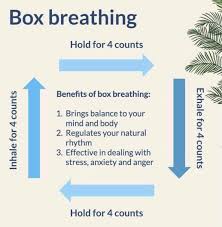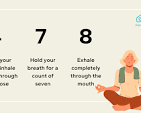The Power of Breathing Exercises for Mind and Body Wellness
Breathing is a fundamental aspect of our existence, but it is often overlooked as a tool for improving our overall well-being. Incorporating breathing exercises into your daily routine can have profound effects on both your mind and body.
One popular breathing exercise is diaphragmatic breathing, also known as belly breathing. This technique involves taking slow, deep breaths that engage the diaphragm, resulting in increased oxygen flow to the body and a sense of calmness and relaxation.
Another effective breathing exercise is alternate nostril breathing, a practice rooted in ancient yoga traditions. By alternating the inhalation and exhalation between the left and right nostrils, this technique helps balance the body’s energy channels and promote mental clarity.
Breathing exercises are not only beneficial for reducing stress and anxiety but also for improving focus and concentration. By paying attention to your breath and practicing mindfulness during these exercises, you can train your mind to be more present and aware.
Research has shown that regular practice of breathing exercises can lower blood pressure, improve lung function, boost immune system function, and enhance overall cardiovascular health. These simple yet powerful techniques are accessible to anyone and can be done anywhere at any time.
Whether you incorporate breathing exercises into your morning routine, use them to unwind after a long day, or practice them during moments of stress or overwhelm, the benefits are undeniable. Start exploring the transformative power of conscious breathing today for a healthier mind and body.
8 Benefits of Breathing Exercises for a Healthier, Happier You
- 1. Reduces stress and anxiety levels.
- 2. Improves focus and concentration.
- 3. Enhances relaxation and promotes better sleep.
- 4. Boosts immune system function.
- 5. Increases energy levels and reduces fatigue.
- 6. Improves lung function and respiratory health.
- 7. Lowers blood pressure and heart rate.
- 8. Helps in managing emotions and promoting emotional well-being.
5 Potential Drawbacks of Breathing Exercises to Consider
- Breathing exercises may not be suitable for individuals with certain respiratory conditions, such as asthma or chronic obstructive pulmonary disease (COPD).
- Some people may find it challenging to focus on their breath and maintain a consistent practice, especially if they have a busy or distracted mind.
- In rare cases, deep breathing techniques can cause dizziness or lightheadedness, particularly if done too quickly or excessively.
- Breathing exercises alone may not be sufficient to address complex mental health issues and should not be seen as a replacement for professional therapy or medication.
- It’s important to learn proper breathing techniques from a qualified instructor to avoid potential strain on the respiratory muscles or improper breathing patterns.
1. Reduces stress and anxiety levels.
Breathing exercises offer a powerful solution for reducing stress and anxiety levels. By engaging in deep, intentional breathing techniques, individuals can activate the body’s relaxation response, calming the nervous system and promoting a sense of tranquility. The act of focusing on the breath also helps to redirect attention away from stressful thoughts and external pressures, allowing for a moment of mental clarity and emotional balance. Regular practice of breathing exercises has been shown to lower cortisol levels, decrease heart rate, and improve overall feelings of well-being, making it an effective tool for managing stress and anxiety in daily life.
2. Improves focus and concentration.
Breathing exercises have been shown to significantly enhance focus and concentration. By engaging in mindful breathing practices, individuals can train their minds to be more present and aware of the current moment. The act of focusing on the breath helps quiet the mind, reduce distractions, and improve cognitive function. This heightened sense of concentration not only benefits daily tasks but also enhances productivity and performance in various activities, ultimately leading to a more focused and efficient mindset.
3. Enhances relaxation and promotes better sleep.
Breathing exercises have been shown to enhance relaxation and promote better sleep. By engaging in deep, intentional breathing techniques, individuals can activate the body’s relaxation response, which helps reduce stress and anxiety levels. This state of calmness not only improves the quality of sleep but also helps individuals fall asleep more easily and experience more restful and rejuvenating rest. Incorporating breathing exercises into a bedtime routine can signal to the body that it is time to unwind and prepare for a peaceful night’s sleep, ultimately leading to improved overall well-being.
4. Boosts immune system function.
Engaging in regular breathing exercises has been shown to boost immune system function. By improving oxygen flow throughout the body and reducing stress levels, breathing exercises help support the immune system’s ability to defend against illnesses and infections. A strong immune system is essential for overall health and well-being, and incorporating breathing exercises into your daily routine can be a simple yet effective way to enhance your body’s natural defense mechanisms.
5. Increases energy levels and reduces fatigue.
Engaging in regular breathing exercises can significantly boost energy levels and combat feelings of fatigue. By focusing on deep, intentional breathing, you enhance oxygen flow throughout your body, revitalizing cells and tissues. This increased oxygenation not only provides a natural energy boost but also helps reduce the accumulation of toxins that can contribute to feelings of sluggishness. Incorporating breathing exercises into your daily routine can leave you feeling more invigorated, alert, and ready to tackle whatever challenges come your way.
6. Improves lung function and respiratory health.
Improving lung function and respiratory health is a significant benefit of incorporating breathing exercises into your daily routine. By engaging in deep breathing techniques, you can strengthen the muscles involved in respiration, increase lung capacity, and enhance the efficiency of oxygen exchange in the body. Regular practice of breathing exercises can help reduce the risk of respiratory conditions such as asthma and chronic obstructive pulmonary disease (COPD), as well as improve overall respiratory function for better endurance and vitality. Prioritizing respiratory health through mindful breathing can lead to a healthier, more energized lifestyle.
7. Lowers blood pressure and heart rate.
One significant benefit of incorporating breathing exercises into your daily routine is their ability to lower blood pressure and heart rate. By engaging in deep, intentional breathing techniques, such as diaphragmatic breathing or alternate nostril breathing, you can promote relaxation and reduce stress levels. As a result, the body’s response to stress hormones decreases, leading to a decrease in blood pressure and heart rate. This natural way of calming the body not only supports cardiovascular health but also helps in achieving a sense of calm and balance in both mind and body.
8. Helps in managing emotions and promoting emotional well-being.
Breathing exercises play a crucial role in managing emotions and promoting emotional well-being. By focusing on deep, intentional breaths, individuals can regulate their emotions, reduce stress levels, and cultivate a sense of calmness and clarity. This mindful practice allows individuals to connect with their inner selves, acknowledge their feelings without judgment, and respond to challenging situations with a greater sense of control and composure. Incorporating breathing exercises into daily routines can help individuals navigate through emotional turbulence more effectively, leading to improved emotional resilience and overall well-being.
Breathing exercises may not be suitable for individuals with certain respiratory conditions, such as asthma or chronic obstructive pulmonary disease (COPD).
It is important to note that breathing exercises may not be suitable for individuals with certain respiratory conditions, such as asthma or chronic obstructive pulmonary disease (COPD). For these individuals, certain breathing techniques could potentially exacerbate their symptoms and lead to respiratory distress. It is crucial for individuals with such conditions to consult with a healthcare professional before incorporating any new breathing exercises into their routine to ensure that they are safe and appropriate for their specific health needs.
Some people may find it challenging to focus on their breath and maintain a consistent practice, especially if they have a busy or distracted mind.
For some individuals, engaging in breathing exercises can present challenges, particularly when it comes to focusing on their breath and establishing a regular practice. This difficulty may be exacerbated for those with busy or easily distracted minds, making it harder to maintain consistency in their breathing routine. The constant stream of thoughts and external distractions can hinder their ability to fully immerse themselves in the practice, potentially diminishing the effectiveness of the exercise in promoting relaxation and mindfulness. Overcoming these obstacles may require patience, perseverance, and the implementation of strategies to quiet the mind and create a conducive environment for successful breathing exercises.
In rare cases, deep breathing techniques can cause dizziness or lightheadedness, particularly if done too quickly or excessively.
In rare instances, deep breathing techniques used in breathing exercises may lead to dizziness or lightheadedness, especially if performed too rapidly or excessively. This side effect can occur due to an imbalance in oxygen and carbon dioxide levels in the body caused by overzealous breathing. It is important for individuals engaging in breathing exercises to be mindful of their pace and intensity to avoid potential adverse reactions such as dizziness, ensuring a safe and comfortable experience.
Breathing exercises alone may not be sufficient to address complex mental health issues and should not be seen as a replacement for professional therapy or medication.
It is important to recognize that while breathing exercises can be a valuable tool for managing stress and promoting relaxation, they may not provide a comprehensive solution for addressing complex mental health issues. Breathing exercises alone should not be viewed as a substitute for professional therapy or medication when dealing with conditions such as severe anxiety, depression, or other mental health disorders. These conditions often require specialized treatment and support from trained mental health professionals. While incorporating breathing exercises into a self-care routine can be beneficial, it is crucial to seek appropriate professional help when facing significant mental health challenges.
It’s important to learn proper breathing techniques from a qualified instructor to avoid potential strain on the respiratory muscles or improper breathing patterns.
To avoid potential strain on the respiratory muscles or developing improper breathing patterns, it is crucial to learn proper breathing techniques from a qualified instructor. Without proper guidance, individuals may inadvertently engage in breathing exercises that could lead to overexertion of the respiratory muscles or disrupt the natural rhythm of breathing. A qualified instructor can provide personalized instruction, ensuring that individuals practice breathing exercises safely and effectively to maximize their benefits while minimizing the risk of any negative impacts on respiratory health.



